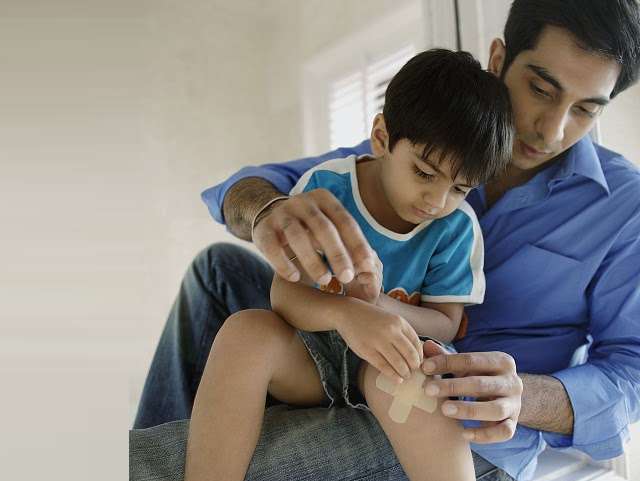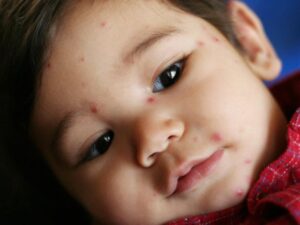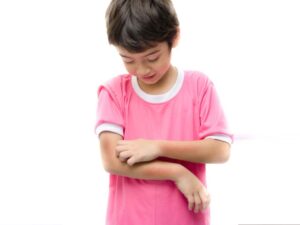Crisis tends to hit the household when medical help isn’t handy. The mind freezes as panic takes over, and you end up doing something silly like putting toothpaste on a burn. Here’s what you should do..
(1) The “Do’s and Don’ts” of skin burns-
Has your child burnt his hand with a firecracker? Have you had hot oil splatter on your face? What does one do while you wait for a doctor’s appointment? Should I wrap a towel over it? Or should I soak the part in water?
How you manage your burn in the first 24 hours will dictate how the burn will eventually heal and if you’ll be left with a scar. Splash cool water on the burnt area for several minutes, and apply ice on it for a few seconds, 2-3 times a day to soothe the area. Do not apply egg white to the burn. Raw eggs harbour multiple bacteria which can infect the wound. Do not use bandaids or fluffy cotton. Do not pop any blisters. Cover the area with wet gauze like Sofratulle. Apply an antibiotic ointment like Fucidin. It is important to keep the area moist with unscented antiseptic creams. If you don’t have one, then use Vaseline petroleum jelly. Wash the affected skin with an unscented antibacterial Triclosan soap. Take pain medication like Paracetamol or Tylenol.
Dermatologists no longer prescribe Silverex cream as the silver content can stain and darken the skin. Turmeric is an excellent home remedy for superficial burns. But avoid turmeric in open wounds which are oozing, as the turmeric forms a dry cake over the wound which peels off the fresh skin underneath.
Most importantly, make an urgent appointment to meet with your dermatologist at the earliest. For deep and extensive burns, rush to your nearest hospital and ask for the services of a plastic surgeon. Your dermatologist/plastic surgeon team can also work together on healing any residual marks or scars from the burn.
(2) Does your child have Chicken Pox?
Does your child have fever and little itchy watery blisters over his body? Chicken Pox is not fatal or dangerous in children. Give tepid sponging for fever, and Paracetamol for aches and pains. Chicken Pox does not leave any marks or scars, unless the blisters have been popped. Cetrizine will help with the itching, and let your child wear mittens as an added measure. Your child’s caretaker during this period should be someone who has already had Chicken Pox, as they are now immune to the virus. Your child can have a cool shower, but do not use towels for drying. Let your child’s body dry naturally under a fan. Make sure they stay out of the sun, get plenty of rest, fluids, and clean nutritious home-cooked meals. Warm saline gargling can soothe a sore throat. Apply Calamine or Soframycin cream to the blisters. Use Cetrilak shampoo if there are blisters and scabs on the scalp as well. When all the blisters turn into dark scabs, you can tell that your child is no longer contagious. Keep a close watch for similar symptoms in other family members.
(3) Suffering from a nasty sunburn?
This is what happens when you’re not sunscreen-smart. But lectures aside, how does one manage sun burn? Have a cold shower, apply cool compresses to the affected area and use Calamine or Aloe Vera based moisturizing lotions several times a day to take the edge off the sting. Drink plenty of fluids and electrolytes, and take anti-inflammatory pills like Ibuprofen for some pain relief. Sunscreen may sting your skin at this point, so keep the sun burnt area covered with clothing and stay indoors till your skin heals. However, if your skin is swollen, blistered or extremely painful, then rush to your dermatologist. Sunburns can be particularly severe in children, and requires immediate medical attention. Multiple episodes of sunburn, especially in childhood, increase your risk of developing skin cancer as an adult. So do not skip the sunscreen.
(4) Head lice invasion in your household?
When it comes to head lice, home remedies do not always work. Mums use vaseline petroleum jelly and mayonnaise to coat their kid’s scalp as a treatment for head lice. This does not always work in suffocating the lice or their eggs. It may only stun them for a while, and you will still have to use a lice comb to get the lice out. Besides, it’s a nightmare to wash all that mayonnaise out!
If your kid has been around someone with lice, then use olive oil and a hot towel instead of vaseline. But if you SEE lice on your child’s head, then consult a dermatologist for medical management. Shaving your child’s head or swimming in chlorinated water will not get rid of head lice.
Lice shampoos must be used by ALL members of the family. Permethrin containing lice-shampoos work the best. If there are nits on the eyelashes, apply a generous layer of petroleum jelly to your child’s eyelashes while he/she is asleep. Wash off the next morning. Remember to clean the lice comb in hot water, vinegar or Lysol. Wash all clothes and bed linen at the end of the treatment. Skipping these simple steps is the most common reason for treatment failure.
(5) Are pinworms tormenting your child?
You might actually be able to see the tiny white thread worms around your child’s anus. You might also find them in your child’s underwear. The itching is worse at night leading to crankiness and restless sleep. In female children, it can cause vaginal itching as well. They can even irritate the urethra and cause bed-wetting episodes in children who have been potty-trained. You can gently stick a piece of cellotape to your child’s anus and get rid of the worms and their eggs. You can also apply menthol or camphor based cream on your child’s bottom, to suffocate the worms. This is only a temporary measure so your child can have a peaceful night till you can get them to the doctor’s office the next day.
Encourage hand hygiene to avoid infection in the future.
(6) How can I avoid catching a skin infection from my pet?
– Check your pet regularly for fleas, sores or patchy hair loss. If you see a rash, non-healing wound or areas of bald skin on your pet’s fur, take him to a vet without delay.
– If you or your pet suffer from an open wound, keep the wound covered. MRSA, a particularly virulent and antibiotic-resistant strain of the bacteria Staph Aureus, can be spread from animals to human. Do not let your pet lick your wounds.
– Scabies and fungal skin infections can be passed on from animals to humans. If you are adopting a stray, make sure to take your new pet to a vet for a thorough examination, followed by prompt treatment if found necessary.
– If you have suffered a bite or a puncture wound from an animal or pet, consult your physician at the earliest, even if the injury was accidental. The risks are higher if the animal was a stray, if the wound was deep enough to draw blood, and if the bite is closer to the head or neck.
– Wash your hands before and after handling pets.
(7) What should I do if I’m stung by an insect?
If you were stung by a snake or a scorpion, do whatever you can to find yourself in a hospital at the earliest. If you are stung by a bee, wasp, spider or caterpillar, here’s what you can do till you can meet your doctor.
Place an icepack on it. Keep the affected limb elevated for some time. Do not itch or shake vigorously as it encourages the spread of the venom. Apply Hydrocortisone cream every 4-6 hours. Take an antihistamine like Cetrizine or Benadryl. Take an anti-inflammatory drug like Tylenol or Ibuprofen, if you have pain and swelling. Meet your doctor if the rash/pain worsens over the next 12-24 hours.
Home remedies and old granny’s concoctions, while well-meaning, do not always work. In fact in some cases, they’re bad advice which can make matters worse. Your first aid kit at home must contain the following basic OTC medications – Betadine (preferable to Dettol or Savlon), Hydrocortisone 1% cream, Aloe Vera, Calamine lotion, Tablet Benadryl, Tab Paracetamol, Tablet Ibuprofen and Mupirocin ointment. These medications can provide relief till you can get an appointment with your doctor. In some cases, they can even relieve your symptoms completely and save you a trip to the hospital. Be Aware, Be Smart!




